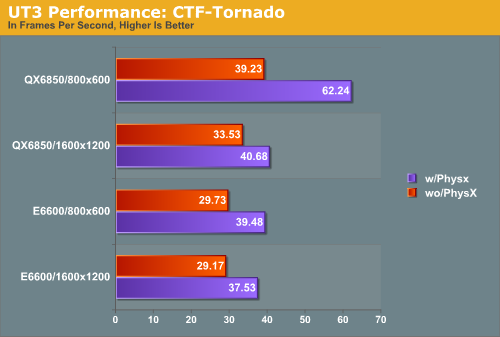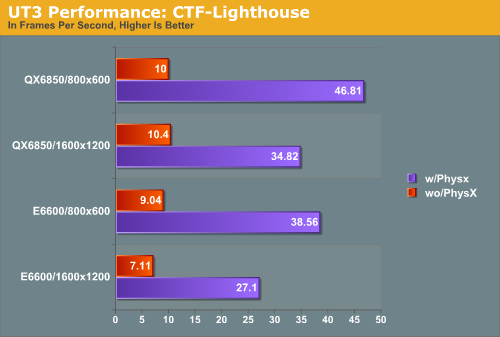PhysX’s Big Break? Unreal Tournament 3 PhysX Performance
by Ryan Smith on December 14, 2007 12:00 AM EST- Posted in
- GPUs
PhysX Performance Under UT3: AGEIA’s Maps
To start things off, we’ll begin with the physically demanding situations from AGEIA’s map pack before moving on to the stock UT3 maps. As AGEIA’s showpieces, these maps will trend to being PPU limited.


Although UT3 isn’t a particularly resource-hogging game, it does tend to be GPU limited more than any other situation. We see that on our 1600x1200 tests, where CTF-Tornado performs very similarly with both of our processors when PhysX enabled. What we end up with overall are very balanced results that show that everything can be a bottleneck at some point.
As we hinted at earlier, CTF-Tornado is generally playable with or without the PhysX PPU with any of our setups. Adding the PPU adds anywhere between 20-25% in our more realistic 1600x1200 situations, to 30-60% when we move away from the GPU bottleneck. However what the benchmarks don’t show is the performance of the map at its lowest; UT3 doesn’t give us the lowest frame rate values for these situations, but when staring directly in to the tornado – the most physically demanding action on this map – performance is certainly dropping in to the single digits. This is fine for bot matches, but this would be impractical for online play.
CTF-Lighthouse on the other hand shows massive performance improvements, and is completely unplayable without a PPU, where it’s literally a slideshow. Adding the PPU increases performance by a minimum of 280%, a welcome change from the PPU driving performance down in some of our past benchmarks. Even with the PPU however, CTF-Lighthouse struggles to be smooth at times, staying just on the side of playability. With no real way to vary the physics load we can’t test all possible options, but we believe it’s very likely that we’re PPU limited on this map, certainly at 800x600 when the GPU bottleneck is removed.
We also have a quick look at CPU usage for UT3 when running this map, to get an idea of just how well the CPU is being used; if it’s not being well used by the software PhysX simulations, then CTF-Lighthouse in particular is not a fair comparison. UT3 is designed around dual-core processors with some light helper threads to occupy cores 3 and 4, so if physics are the bottleneck then the multithreaded software PhysX simulations should be able to completely load the CPU.

However we are not seeing this. CPU usage is hovering at a little below 60% total usage on our QX6850. Given that we're not GPU limited, one thread in particular must be the CPU limited thread, and isn't capable of being further split. Our first thought is that the thread(s) that handle game logic also are doing the software physics, which would explain why we're not seeing a greater use of the other cores for the physics calculations. It's unfortunate if this is the case though, as it means that Unreal Tournament 3 (and possibly other Unreal Engine 3 games) is unable to fully utilize more than 2 cores and change. It also means that we potentially could be getting better software performance, which works against the PhysX hardware.
Never the less, this map is certainly designed to be a best-case scenario for the hardware, which is exactly what it delivers.










29 Comments
View All Comments
madgonad - Friday, December 14, 2007 - link
If most of the games arriving are enabled with this technology at a minimum it would give an equivalent boost of going from dual to quad core on regular maps using 2nd order physics. For games/maps using 1st order physics it would actually allow you to play them. For a $100 part (I have seen priced at $149) that might make sense if you have room in the case and PCIe 1x cards become available as a working product.For most of us, you know, people that build/buy a PC under a budget, this may or may not make sense. A physics processor may fall into the category of sound card since Vista and Realtek has taken great strides in making the previously mandatory sound card irrelevant. They might provide a couple "nice to have" features and slightly improve performance, but that money might be better spent on Crossfire or a faster CPU or better RAM or a mirrored hard disk.
The physics card is going to have to earn a place and this article does support that ability.
Heck, if it allows players to chew up the scenery I am all for it!
kilkennycat - Friday, December 14, 2007 - link
nVidia's upcoming dual-function next-gen silicon fully supporting either GPU or GPGPU functionality will finally kill PhysX. Wonder why the 780i chipset supports 3 PCIe16 slots and PCIe2.0? Think 2 GPUs in SLI dedicated to graphics and one GPU functioning as a GPGPU for bleeding-edge gaming. And for the less than bleeding-edge gaming, quad-core computation of bulk physics in combo with spare GPU horsepower for particle-effects will do quite nicely.Ryan Smith - Friday, December 14, 2007 - link
The funny thing is that at this time last year I'd agree with you, but now I'm not so sure.GPU physics has been a bust so far. ATI/NVIDIA made a bunch of noise when AGEIA announced their PPU, but HavokFX never came through and there is no other off-the-shelf solution that can do second-order physics, never mind first-order physics. It always seems like GPU physics in games is just around the corner and it never happens, and I'm not convinced that this misdirection from the GPU manufacturers is unintentional.
I keep hearing conflicting stories about when we'll get real GPU physics. Now the story is that things will finally be put in order forcefully by Microsoft in DirectX11, which is still years away (MS is still working on delivering DX10.1). This would coincide with some improvements in GPU threading that would help GPUs deal with the split workload, so it's very possible this is the case. Then again, both ATI and NVIDIA are finally delivering mature versions of their GPGPU programing environments (CUDA/CTM) which would allow someone to write a physics package at a lower level than shaders. I'm not aware of anyone working on this for games, though.
In the mean time the PPU does exist, and we expect we'll be seeing a far more powerful version fairly soon.
The 780i isn't the only chipset that supports 3 PCIe x16 slots either. I can show you some boards that came through here in 2005 that had the same support, for the exact same reason. Furthermore NVIDIA has a poor track record of supporting >2 GPUs in a system at once anyhow.
NickelPlate - Friday, December 14, 2007 - link
Let's hope so. The last thing PC gaming needs right now is another hardware requirement on the box.Martins - Friday, December 14, 2007 - link
So we don't need another Hardware requirement on the Box? In the form of a PPU that is $99 now and that as shown that can be faster them a $400+ dual core right? But you are not against the use of 3 or more GPU's and a new board if you want physics hardware acceleration, just do the math and see who gives us the best bung for ours money.NickelPlate - Friday, December 14, 2007 - link
I'm not saying their isn't a performance benefit. But the fact is PC gaming has slowly been taking the backseat to consoles over many years, mostly because it's getting more complicated and expensive for the average user. It's already depressing enough for most people to buy a high end graphics card only to have it chug on new games within years time. What's going to happen when they need a PPU upgrade every year also? Another $100? More? That's probably for the cheap ones. No doubt high end PPU cards will be end up costing hundreds.goku - Monday, December 17, 2007 - link
No, I think the problem is, pc gaming and well gaming in itself hasn't offered much innovation in a long time. A PPU would add a great amount of depth that is so sorely needed in today's games. What's the point of a high resolution tree if all you can do is cut it down in the same way as any other tree? Or how about driving a beautifully rendered car, but when you crash it, the damage is the same EVERYTIME.rykerabel - Wednesday, December 19, 2007 - link
wyrdI bought a physix just to put my money into encouraging some decent physics in the future.
I don't care which company succedes, i just want better physics period.
ChronoReverse - Friday, December 14, 2007 - link
Where are you getting this $400 dual core? Quad cores start at $279 now and dual cores can be had for less than $75 (soon even lower when the dual core Celerons come out).michal1980 - Friday, December 14, 2007 - link
I find that your statement of pc's not needed more new hardware just flat wrong.read the dailytech thread about display port. People are throughing themselves at a new port hand over fist. Those same people what physic's hard just because